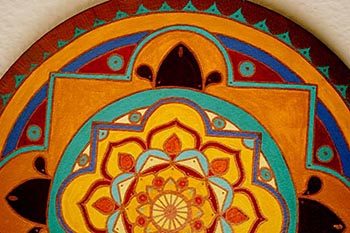
Mantra: Gate, Gate, Paragate
Buddhist Chant from the Heart Sutra
This mantra known as “Gate, Gate, Paragate” is found in the Heart Sutra, one of the best-known Buddhist scriptures. Most translations are as follows: “Awakening that is gone, gone, gone to the furthest shore, gone completely to the furthest shore.”
Share this page with a friend!
Heart Sutra Lyrics
Gate Gate Paragate (The Heart Sutra)
Gate Gate Paragate Parasum Gate Bodhi Svaha (2x)
Gate Gate Paragate Parasum Gate Bodhi Svaha (2x)
Bodhi Svaha, Bodhi Svaha, Bodhi Svaha
Bodhi Svaha, Bodhi Svaha
Watch nearly 400 videos on the Vocal Medicine Channel!
The video above is a quick, fun and lively video created in collaboration with Beth Dielle Ciesco using an excerpt of my version of the Heart Sutra Mantra combined with her bright, cheerful mandalas. Beth is a visionary artist, yoga and meditation teacher. Visit Beth’s website at Divine Me Time.
History of the Heart Sutra
The Heart Sutra is part of the Mahayana Buddhist tradition. In this sutra, Avalokitesvara explains human existence and emptiness. The origin of the sutra is disputed, though thought to date from at least the 8th century. There are dozens of translations of this text, including a short version and a long version. The title is usually translated as “The Heart of the Perfection of Wisdom.”
Purpose of the Heart Sutra
The Heart Sutra mantra (Gate Gate Paragate Parasum Gate Bodhi Svaha) has been chanted for centuries by countless monks, nuns and lay practitioners. This is a powerful healing mantra which seeks to alleviate all illusion, including suffering, pain and death. This mantra exemplifies the “space” or “ether” element, one of the five fundamental Vedic elements. Learn more about Five Element Mantras.
Watch nearly 400 videos on the Vocal Medicine Channel!
Text of the Heart Sutra
In the Heart Sutra, Avalokitesvara is addressing Sariputra, a central disciple. The following is a portion of a translation by Bill Porter, who goes by the pen name of Red Pine. He translates Chinese texts, primarily Taoist and Buddhist. In 2018, he won the American Academy of Arts & Letters prize for translation:
The noble Avalokiteshvara Bodhisattva,
while practicing the deep practice of Prajnaparamita,
looked upon the Five Skandhas
and seeing they were empty of self-existence,
said, “Here, Shariputra,
form is emptiness, emptiness is form;
emptiness is not separate from form, form is not separate from emptiness;
whatever is form is emptiness, whatever is emptiness is form.
The same holds for sensation and perception, memory and consciousness.
Here, Shariputra, all dharmas are defined by emptiness
not birth or destruction, purity or defilement, completeness or deficiency.
Therefore, Shariputra, in emptiness there is no form,
no sensation, no perception, no memory and no consciousness;
no eye, no ear, no nose, no tongue, no body and no mind;
no shape, no sound, no smell, no taste, no feeling and no thought;
no element of perception, from eye to conceptual consciousness;
no causal link, from ignorance to old age and death,
and no end of causal link, from ignorance to old age and death;
no suffering, no source, no relief, no path;
no knowledge, no attainment and no non-attainment.
Therefore, Shariputra, without attainment,
bodhisattavas take refuge in Prajnaparamita
and live without walls of the mind.
Without walls of the mind and thus without fears,
they see through delusions and finally nirvana.
All buddhas past, present and future
also take refuge in Prajnaparamita
and realize unexcelled, perfect enlightenment.”
Watch nearly 400 videos on the Vocal Medicine Channel!
The Vedic Space Element
The breadth of the galaxy is one of the most useful metaphors for the concept of “emptiness.” Although the galaxy is far from empty, the distances between celestial bodies provides a sense of the infinite. There are no boundaries. There are no hard divisions. The galaxy symbolizes freedom, expansiveness, and endless vistas.
Inspiration from the Galaxy
Contemplating the galaxy dramatically shifts naturalistic perspective into infinite possibilities. Your psychological and emotional states can be completely altered. The sense of endless space becomes a new kind of awareness spreading outward and inward at the same time. This experience can be a daily source of inspiration.
Characteristics of the Ether Element
Individuals with a strong affinity for the space or ether element are characterized by the qualities of strength, endurance, idealism, discipline and will. They have high aspirations and are often involved in creative expressions that seek to uplift life.
Ether Element Personalities
Space or ether element personalities draw the viewer to the core issues in life such as ethics, morality, philosophy, religion, and the underlying principles revealed through the best of higher learning. Those with a strong affinity to the space element seek quality rather than quantity in life. Learn more about the Vedic system of energy transformation and Five Element Mantras.
HEART SUTRA ARTICLE SUMMARY
This article explores one of the most well-known Buddhist texts and mantras. The history and text of the Heart Sutra are included as well as a music video of the mantra titled “Gate Gate Paragate.” The Heart Sutra is part of the Mahayana Buddhist tradition. This sutra explains human existence and emptiness. The Heart Sutra mantra has been chanted for centuries by countless monks, nuns and lay practitioners. This is a powerful healing mantra which seeks to alleviate all illusion.
Click for all content on our Site Map
Author Kathleen Karlsen
Kathleen Karlsen is a musician, artist, writer and speaker. She is the author of two books (Flower Symbols and Vocal Medicine) and over 200 articles. Kathleen, her husband Andrew, and their five children live in Bozeman, Montana. More about Kathleen Karlsen.





